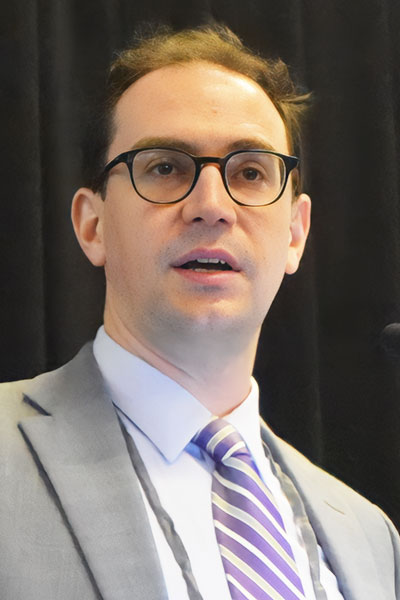
In critical care, there can be gray areas. Sometimes there is more than one right choice for patient care after a heart attack, and individuals may receive care in cardiac, neurological, medical, or surgical ICUs. As such, intensivists in every ICU practice environment must know how to manage patients post-cardiac arrest.
Controversies in Post-Arrest Management in the ICU on Monday at CHEST 2022 took an innovative approach to exploring care options by asking the session’s attendees to decide, table by table, how they would approach the case studies presented.
“We’re glad to be here in person, and this is really about sharing each other’s experiences and perspectives,” said Session Chair and Panelist Benjamin Kenigsberg, MD, codirector for the medical cardiovascular ICU at MedStar Washington Hospital Center.

A panel of experts presented three case studies, and after each one, offered four options for care, coded as A, B, C, and D. Each table had four corresponding cards, and a group representative held up the letter for the option the table members chose by consensus. De facto Session Emcee Steven Hollenberg, MD, FCCP, professor of medicine at Emory University School of Medicine, explained the format.
“This is designed to be a clinical dilemma at the edge of the data-free zone,” Dr. Hollenberg said. “Ideally, we won’t all have the same answers.”
Although additional data were presented after each case, the bulk of the session time was spent discussing the tables’ choices for care.

Tani Jausurawong Wiest, DO, critical care specialist at MedStar Washington Hospital Center, presented the first case: a 45-year-old male with a history of hypertension and diabetes is admitted to the cardiac ICU after an out-of-hospital cardiac arrest (OHCA) while playing soccer.
The audience had four options for care utilizing targeted temperature management (TTM) and discussed the pros and cons of each. Panelists also discussed additional details about TTM applicability.
Scott DeBoer, MD, PhD, assistant professor of neurology at Georgetown School of Medicine and director of neurocritical care at MedStar Franklin Square Medical Center, presented the second case: a 45-year-old with a history of intravenous heroin use is found by family after dinner. EMS finds the patient with pulseless electrical activity and starts cardiovascular life support, and the patient is intubated. Upon arrival at the hospital, the patient is admitted to the ICU.

Tables again had four options applying to TTM protocols, and attendee responses were evenly divided between two of the four choices. Dr. DeBoer showed additional slides that led to a discussion on neuroprognostication and giving patients enough time to recover.
In the last case study, Dr. Kenigsberg presented a 40-year-old man with a history of hyperlipidemia and hypertension with OHCA. Bystander CPR preceded EMS finding the patient with ventricular fibrillation that persisted after repeat shocks. The four treatment choices involved admittance to the ICU, ECMO, additional testing in the catheterization laboratory, and ceasing life support.
Tables held up cards for ICU, ECMO, and catheterization laboratory, and each course of action had various supporting arguments. Dr. Kenigsberg provided statistics about the risks and benefits of coronary angiography after cardiac arrest to supplement the discussion. Dr. Hollenberg then carried the microphone from table to table to broadcast attendees’ comments.
“This is exactly what I wanted this session to do,” he said. “It elucidates points in those gray areas.”
Join us at CHEST 2025
Save the date for the next Annual Meeting, October 19 to 22, 2025, in Chicago. CHEST 2025 will explore the latest advancements in pulmonary, critical care, and sleep medicine, with a focus on innovation and the future, just as the city itself embodies progress and reinvention.





